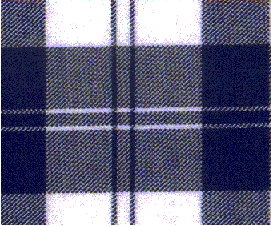The Tartan is the symbol most associated with Highlanders and their Clan. However, it is also the one with the most misconception attatched. Some believe that the tartan was how the Clans distinguished themselves, in battle specifically, with each Clan wearing their distinct tartan, the colors of which are obtained from the plants which were exclusive to that Clans territory. There is some evidence for this, with 16th and 17th century poets associating certain tartans with specific clans. The other explanation, that is generally considered as closer to the truth, is that the tartans of the Clans were invented during the Victorian period, when such things were of great interest (tartan itself derived from a French word, while the highlanders used the term "breachan", which means multicolored). It most likely is a combination of both explanations.
The Celts were observed and recorded by Roman invaders as having an exuberant sense of colour in their clothing, the Romans referring specifically to their striped or checkered garb *35. This simple, two color chequered material has evolved into the multicolored, complicated paterns of modern tartans, with over two thousand being recognized.
The Oliphants have two recognized tartans, that can be seen below. The Ancient, is considered to consist of more basic colors, and is meant to depict the colors more likely seen when the colors were created from vegetables, herbs, and berries. The Modern is an adaptation of this ancient tartan, and can be produced with the synthetic dyes available today.
The Tartan is often called Oliphant/Melville or Melville/Oliphant. Many believe this to be this to be due to the Oliphant Clans connection with Clan Melville in the early times (the Oliphant heiress marriage to the Melville, granting the Melville family Oliphant lands in Kincardine), but it is more likely due to the similarity of the two tartans (which are recorded as seperate and distinct in Vestiarum Scotticum (an authority on tartans completed by the Sobieski Stewart brothers in 1827, but not published until 1842)), which because of their similarity, and the relatively small size of the two Clans, would make more economic sence to the vendors to have as one tartan, however inaccurate.
The tartan can be worn by anyone with the name Oliphant or Kinloch (see Septs), or by anyone who's closest Scottish ancestor carried the name (technically, anyone may wear the Oliphant tartan, however it is unlikely that someone who bears the name, MacKenzie, for example, with a 4th great grandfather who bore the name Oliphant, would wear the Oliphant tartan as opposed to the MacKenzie). Also seen below is the Erskine dress tartan, which is nearly identical to that of the Oliphant's Blue dress, often worn by highland dancers in competition. A dress tartan is generally created by removing one of the main colors (usually the darker), and replacing it with white, along with switching the white lines, to the color replaced.
|









